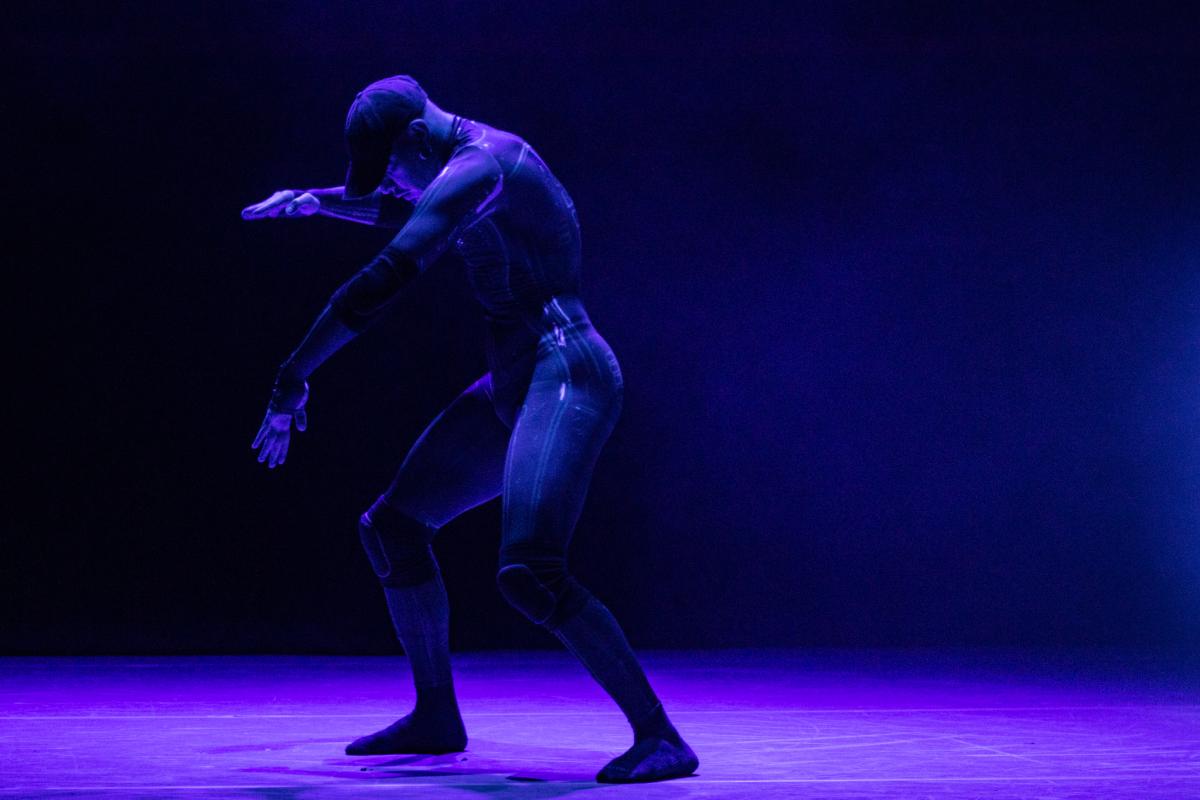Protecting Our Heads: An Escape to Mark Caserta’s “Planet Bone”
Fri, April 21, 2023

This piece is part of a series about BlackLight Summit, written by Ashayla Byrd, a BlackLight Summit Emerging Artist.
A dim, electric blue beam of focused light cascades down a willowy figure clad in a form-fitted suit. Detailed with the futuristic print of a new-age skeleton, the suit is paired with a simple black ballcap. Philadelphia-based dance artist Mark Caserta’s signature, golden teardrop-hoop earring glows in their left ear. They heed the nearly inarticulate words of an omniscient, robotic voice: ”Population: one…contaminated…alone.” The unsettling low hum of the music warns that something sinister is approaching.
It is abundantly clear from the start of this solo work that the name of the game is isolation— “game” being the operative word. “Planet Bone” taps into the escapism and otherworldly nature of video gaming as a coping mechanism for the disheartening reality that they are not ready to actualize their most authentic, queer self. They cannot engage with the world in the way that feels truest to them. As part of The Clarice’s 2023 BlackLight Summit Keep the Light On performance series, the message of connection is gentle, yet earnest.
Shifting from all fours to a crouched, standing position, Mark turns their head from left to right, taking stock of their current state and preparing to introduce their internal sphere. The beginning of Mark’s movement is spineless, jointless. It undulates seamlessly and almost imperceptibly. In the luminescence of a single cobalt spotlight, Mark prudently reaches upward before shrinking back downwards. They crouch lower, arms and spine billowing. Their fingers caress the air. Their head jolts back, inches forward, and jolts back again in a cyclical fashion. Mark comes to, gently shakes their head no, and rapidly circles their hand above their head. They’ve created an impenetrable shield for a prized possession: their mind.
Mark’s prior undulation, billowing and gentle caresses are juxtaposed against almost robotic, repetitive, meticulously isolated movements. They swipe their arms behind them repeatedly, left to right and back again. Their arms cross and open in front of them like blades pruning unruly bushes. Reaching higher and higher, swiping and pruning, Mark clears the “room”– clears this interior world–for their presence. The music drones on, and its baleful sounds permeate the atmosphere. I can clearly see several movement truths existing within the same vessel, and I hold my breath to learn which truth Mark will divulge at any given moment.
“From a very young age, I always felt like I was on the outskirts of things…obviously now in my adulthood, I know that it was because of my queerness.” In my interview with them, Mark recalls the intense loneliness they felt as a result of their family’s ostracization of them throughout childhood. Somehow, they still felt obligated to maintain the ideal of a perfect Italian-American family. Pairing loneliness with obligation compelled Mark to seek out a medium of expression, a true home outside of the house they lived in, and a new pathway for connection with people who nurtured them in their entirety. Dance’s well-timed entry into Mark’s life filled these voids.
In addition to their diligently choreographed, exquisitely executed movement, Mark crafts a scenic environment that further enriches the narrative they aim to convey. In “Planet Bone,” a wall of crates on stage right signifies the metaphorical barriers and mental blockages that Mark created to keep themself from fully embodying all of who they are as a queer, creative individual. On stage left, four upright beams of light symbolize an entrance into the Real World. Mark feels conditioned to move through the world in a reduced state: undetected, unseen and unacknowledged. The beams create a pathway towards the world that Mark so desperately wants to escape.
In concert with the movement and stage design, Mark’s costume choices simultaneously mask and magnify their deepest yearnings and most long-lasting insecurities. “Everyone who knows me is like, ‘protect Mark’s head,’ because I’m always banging my head…[the hat] also serves as a physical manifestation of a protective gear for me. I feel like a superhero when I’m hooded or when I’m covered.” The opening costume—while Mark explores their authenticity—exposes their body freely while the hat covers their face and complements their calm, cool aesthetic. When Mark explores the exterior world, their clothes are darker, baggier and less defined. Their head is no longer protected, and they are susceptible to far more harm, more exposed than ever.
In the spirit of the BlackLight Summit’s call for connection and along the vein of the isolation imbued within “Planet Bone,” I would be remiss if I did not reflect on the necessity for community. This is a word that is often co-opted in white spaces, oversimplified in the media, and abused in the name of so-called solidarity. Community remains paramount to our collective liberation as BIPOC people, queer people, trans people, disabled people, poor people, sex workers, and anyone else surviving at society’s margins. Community is the antidote to our isolation. How can we protect each other? How can the destruction of repressive systems provoke the fortification of a more abundant world, both internally and externally? How can we protect our heads? How can we protect our hearts?
Ashayla Byrd (she/they) is a DC-based dance artist and writer who is dedicated to amplifying the voices of BIPOC, LGBTQIA+ folks. Originally from Virginia Beach, Ashayla is eager to explore the richness of DC’s dance and writing communities!
Photo by Justin Williams.
